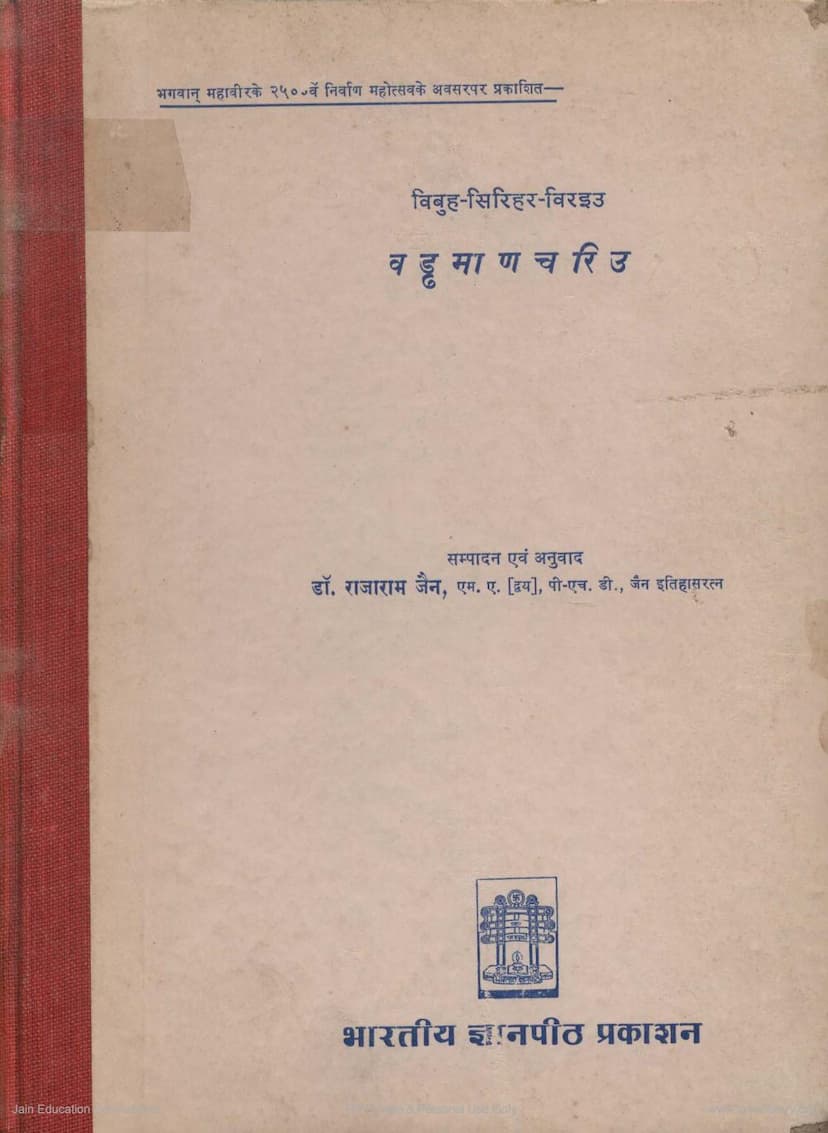Vaddhmanchariu
Added to library: September 2, 2025

Summary
Here's a comprehensive summary of the Jain text "Vaddhmanchariu" based on the provided catalog link and text excerpts:
Book Title: Vaddhmanchariu Author: Vibhuha Sirihar (also referred to as Vibudha Sridhara) Editor & Translator: Dr. Rajaram Jain Publisher: Bharatiya Jnanpith Catalog Link: https://jainqq.org/explore/001718/1
Overview:
"Vaddhmanchariu" is a significant work in the Apabhramsa language, composed by Vibudha Sridhara in the 12th century VS (Vikram Samvat). It is notable for being one of the earliest independent works in Apabhramsa focused on the life of Lord Mahavira. The book was published by Bharatiya Jnanpith as part of their Māna Pītha Mūrtidevi Granthamālā series, specifically as Apabhramsa Granth No. 14, to commemorate the 2500th Nirvana Mahotsava of Lord Mahavira.
Author: Vibudha Sridhara
- Background: Vibudha Sridhara was born into the Agrawala kula. His parents were Vīlha-devi (mother) and Budha Golha (father). He originally resided in Hariyana and later migrated to Yoginīpura (Delhi).
- Works: Sridhara is known for several works in Apabhramsa, including:
- Pasanahacariü (on Parshvanatha) - Composed around 1132 AD.
- Vaddhamana-cariü (on Mahavira) - Composed in 1133 AD.
- Candappahacariü and Samtiņāha-caria are known but not yet discovered.
- Other attributed works include Bhavisayatta kahā and Sukumala-cariü.
- Patronage: He composed his works under the patronage of prominent Jain laymen (Śrāvakas) like Sahu Naftala of Delhi (for Pasanahacariü) and Nemicandra of Vodauva (for Vaddhamana-cariü).
Content and Structure of "Vaddhmanchariu":
- Subject Matter: The work details the life of Lord Mahavira, covering his previous lives (bhavāntaras) as described in Jain tradition and his present life as the last Tirthankara.
- Structure: The "Vaddhmanchariu" is divided into 10 Sandhis (chapters).
- Literary Style: Sridhara's style is characterized by dignified descriptions, reminiscent of a Mahakavya. He employs poetic flavors, various sentiments, and fluent expression. The text is rich in descriptions of towns, battles, festivals, royal courts, and socio-cultural aspects of the period.
- Language: The primary language is Apabhramsa, which Dr. Rajaram Jain notes contains influences from Rajasthani, Braj, Haryanvi, Bundelkhandi, Bhojpuri, and Maithili, making it a fascinating linguistic study. The author also utilizes Sanskrit for colophons and auspicious verses.
- Themes: The text explores themes of renunciation, tapasya (penance), the cycle of birth and death (karma), the importance of right faith, knowledge, and conduct, and ultimately, the path to liberation (moksha).
- Narrative: The first eight Sandhis focus on Mahavira's previous births, illustrating the gradual accumulation of virtues and karmic merit necessary for Tirthankara status. The ninth Sandhi begins with Mahavira's birth and early life, culminating in his attainment of Kevala Jnana (omniscience). The tenth Sandhi covers his teachings and Nirvana.
Editor's Contribution: Dr. Rajaram Jain
Dr. Rajaram Jain's critical edition is highly praised for its exhaustive introduction, which delves into:
- Textual Analysis: Details about the manuscripts used for the edition (from Biyawar, Jhalrapatan, and Dooni), their completeness, and textual peculiarities.
- Author and Period: Comprehensive information about Vibudha Sridhara, his contemporaries, and the dating of his works.
- Literary Aspects: Analysis of the poem's Mahakavya characteristics, poetic embellishments, use of proverbs, and identification of influences from earlier poets like Kalidasa, Bharavi, and Harishchandra.
- Socio-Cultural Insights: The text provides valuable data on socio-cultural, administrative, religious, and historical aspects of 12th-century India, including details on festivals, food, clothing, ornaments, music, architecture, political systems, warfare, and philosophical doctrines.
- Linguistic Study: Dr. Jain's expertise in Apabhramsa is evident in his detailed discussion of language peculiarities, phonological changes, and the influence of regional dialects.
- Appendices and Glossary: The edition includes appendices that present significant portions of Sridhara's other works and comparative charts of Mahavira's life events from various texts. A comprehensive glossary and index are also provided.
Key Features and Significance:
- Early Apabhramsa Work: As the first independent Apabhramsa work on Mahavira's life from the 12th century VS, it holds significant literary and historical value.
- Comprehensive Biography: It offers a detailed account of Mahavira's life, including his pre-births, making it a valuable resource for understanding Jain hagiography.
- Linguistic Treasure: The Apabhramsa text itself is crucial for linguistic research, showcasing the evolution of the language.
- Socio-Historical Data: The work is a rich source for reconstructing the socio-cultural, religious, and political landscape of medieval India.
- Critical Edition: Dr. Rajaram Jain's meticulous editing, translation, and insightful introduction make the text accessible to modern scholars and readers.
- Commemorative Publication: Its release on the 2500th Nirvana Mahotsava of Lord Mahavira underscores its importance in Jain tradition.
Overall Impression:
"Vaddhmanchariu" is a masterful poem that blends devotional narrative with rich poetic artistry. Vibudha Sridhara's work is not only a tribute to Lord Mahavira but also a valuable historical and linguistic document. Dr. Rajaram Jain's scholarly effort in bringing this rare manuscript to light is highly commendable, enriching the field of Jain literature and Indian historical studies.